Remembering Beauty
While Jesus was in Bethany in the home of Simon the Leper, a woman came to him with an alabaster jar of very expensive perfume, which she poured on his head as he was reclining at the table.
When the disciples saw this, they were indignant. “Why this waste?” they asked. “This perfume could have been sold at a high price and the money given to the poor.”
Aware of this, Jesus said to them, “Why are you bothering this woman? She has done a beautiful thing to me. The poor you will always have with you, but you will not always have me. When she poured this perfume on my body, she did it to prepare me for burial. Truly I tell you, wherever this gospel is preached throughout the world, what she has done will also be told, in memory of her.”
— Matthew 26:6-13
In 2001 my husband and I visited friends serving with MCC in post-war Bosnia. It was eye-opening to visit a war-torn location in the process of clean-up and rebuilding. Our friends were living in Sarajevo, a city long known as a European art center.
Stories of how the residents sought to keep art alive in the midst of the war is testimony to art’s significance to life, even to survival — the most famous being the actions of a cellist who boldly and bravely would sit and play in full view of snipers and at extreme personal risk in order to bring beauty to those suffering atrocities and to bring honor to the lives of those killed.

The Cellist of Sarajevo, Vedran Smailovic
When 22 people died in a breadline that was bombed near his home, Vedran Smailovic choose to go out and play 22 days in a row – one day for each victim. It was an act that could easily have been criticized as foolish, unwise, reckless, and a waste. But is beauty ever a waste?
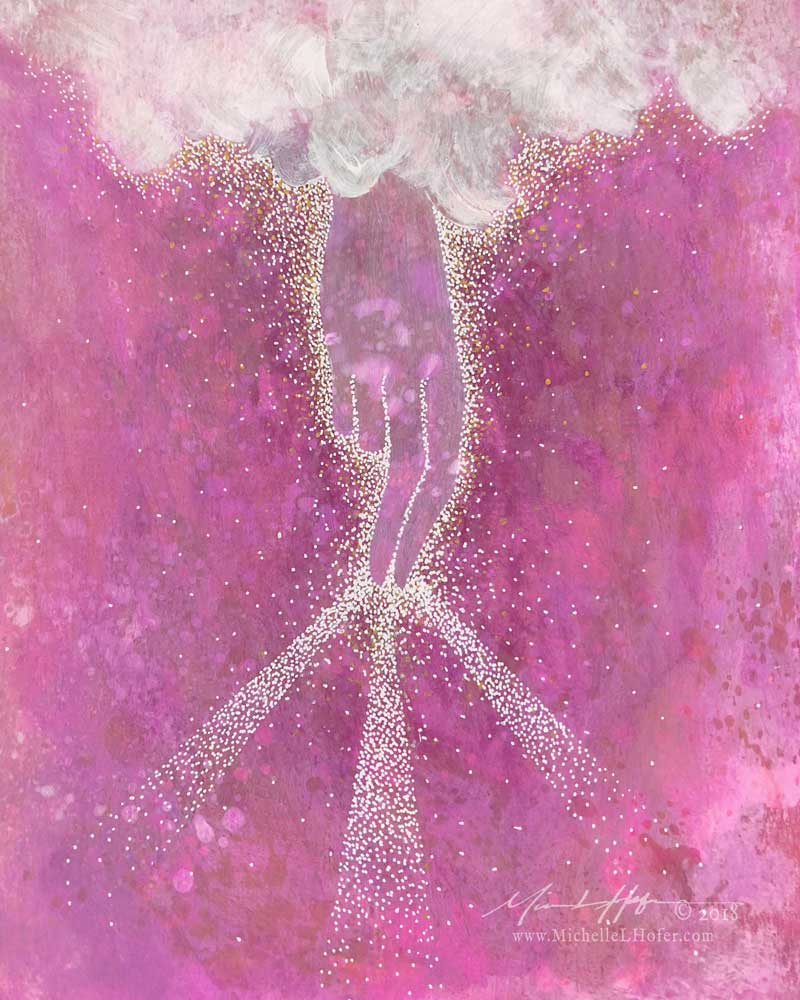
Divine Love, 2018 by Michelle L Hofer
To declare something to be a waste is to say that it is unnecessary, excessive, overly extravagant, or has no purpose or significance. In our Scripture passage we read of such an objection raised by the disciples when a woman came in during supper while Jesus was reclining at the table and poured an entire jar of super expensive perfume on his head. Not understanding the reason or reasons someone would possibly do something considered lavish, the disciples began grumbling, and in other accounts of this story, also scolding the woman for having foolishly done such a thing.
To the disciples’ shock, Jesus defends the woman, declaring that what she has done is “beautiful”.
Now it was a common tradition for Jews and virtually all ancient Middle-Eastern cultures to observe anointing as an act of hospitality. In Luke 7:46 Jesus rebukes Simon the Pharisee for having failed to anoint him and show him basic common courtesy when entertaining him as a guest.
The disciples in the Matthew passage take issue not with the fact that Jesus was anointed at the supper that night, but that the woman who carried out the act used a perfumed oil not meant for that purpose. A simple fragranced olive oil would have been the more appropriate choice. Though Jesus explains the act as being necessary to prepare him for his upcoming burial, the woman was not likely to have had this in mind.
She very well could have used the usual oil for anointing guests, but something in her made her decide that Jesus needed better, in fact he deserved the very best – her act was one of devotion and honor. The action of this woman is by definition an act of worship. What she did was nothing short of excessive, overly extravagant and it served to glorify and give honor to Jesus.
I have a verse posted in my studio that I see and read whenever I’m working…
Live a life worthy of the calling you have received. — Ephesians 4:1b
It’s taken me a fair amount of time to flush out what that calling really looks like for me, but the last few years have been ones of increasing bravery, confidence and focus. I am an artist in the kingdom of God. I do good kingdom work with my artistic gifts.
I’ve experienced much confusion and woundedness in my life over the artistic gift I’ve been given. I have often felt as though I was this woman anointing Jesus with costly perfume and then getting berated by others for having wasted something that could have contributed to helping those in need. I’ve also simply been told that art has no place in God’s work — it can’t be used to express the good news of the Gospel of Christ. I keep the verse posted to remind myself that when statements are made such as…
- art is a luxury rather than a necessity
- aesthetics don’t matter…rather simplicity and practicality
- beauty and art are the hallmarks of materialism and wealth — God’s people are simple, unadorned and so are their homes and places of worship
- the time, money, and materials it takes to create/share art would better be spent ministering to the poor, the sick and the elderly or supporting other acts of service and ministry
These things are often said naively or out of the same critical spirit we find here in the disciples. My calling is to serve God bringing him glory and honor while ministering within the body of Christ and give testimony to the world through the creation and sharing of art/beauty.
One of the most common errors of thought that I bump into is the blanket approach to service in the kingdom – everyone needs to take their turn serving in each role, position or responsibility. Lets face it, there is never a shortage of work to be done in the church, in our communities, in our nation, in the world, but we must be careful not to assume that my service should look identical to your service or her service or his service.
One of the most helpful things anyone has ever said that has aided me in understanding the priority I must give to my unique calling as an ambassador of art and beauty was this…it was spoken by an artist at a Christian arts conference: “I had to realize that it was my responsibility to make art, it was not my job to make and deliver casseroles.”
In compete disclosure, I myself have only ever made and delivered meals a handful of times. I’ve only ever helped at a funeral a handful of times. I’ve never taught children’s Sunday school even though I have children. I have heard grumblings about these seeming infractions and it once caused waves of guilt and shame to come over me. It isn’t that I make art and that’s all I ever do, I just have to be very mindful what I say yes to and how that impacts the time I am able to fulfill my primary calling in life.
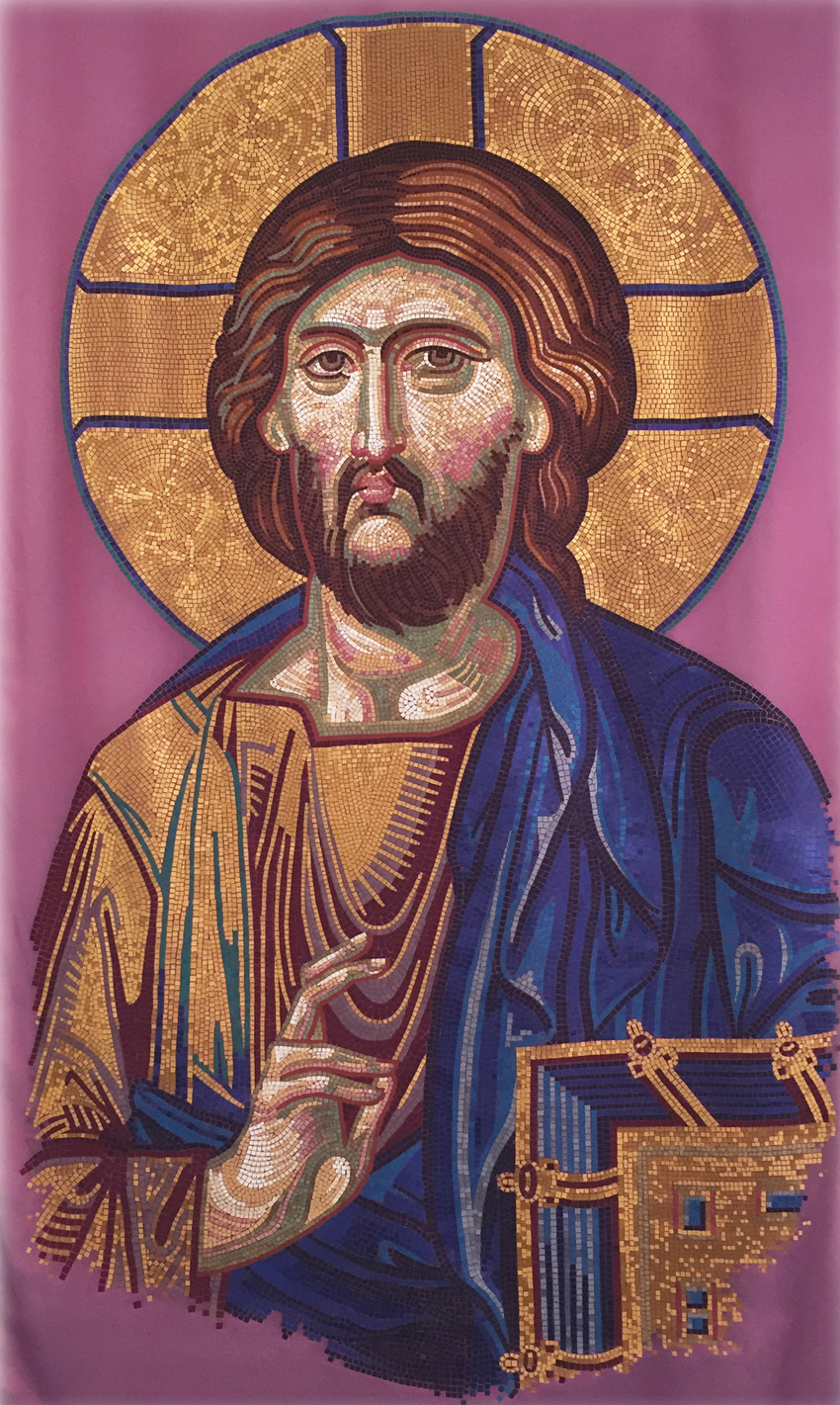
Christ Pantocrator banner (approx. 10ft x 5ft), 2011 by Michelle L Hofer
The piece of art I’d like to share with you about today is my Christ Pantocrator banner. In it I have invested approximately 350 hours of my time in its planning and construction – the most I’ve ever spend on one artwork. This banner is largely an act of worship, extravagant and lavish – it’s my own version of an expensive oil anointing. This work is modeled after a mosaic I saw in person in Istanbul, Turkey and is close to actual size although the original was composed of tiles about half the size of mine and in a far more extensive color palette than mine.
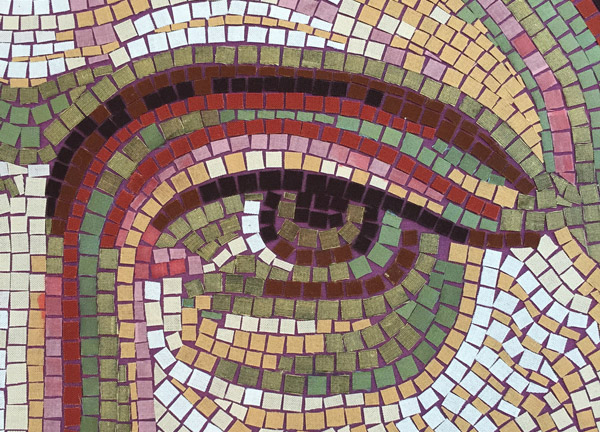
Christ Pantocrator banner (2011) – detail of eye by Michelle L Hofer
It is made up of somewhere around 20,000 1/4 inch to 3/8 inch hand cut tiles from silk, taffeta, satin and cotton fabrics to which an iron-on backing was applied. The tiles where all hand placed and secured 2-3 at a time with a quilter’s applique mini iron.
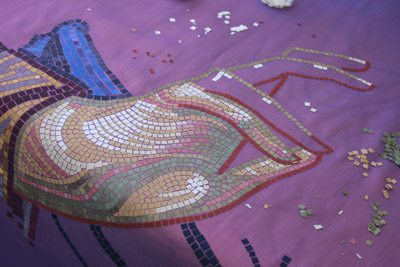
Christ Pantocrator banner (2011) – detail of work on Christ’s hand by Michelle L Hofer
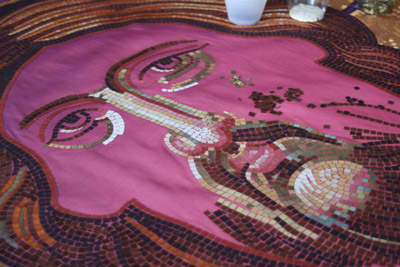
Christ Pantocrator banner (2011) – detail of work on Christ’s face by Michelle L Hofer
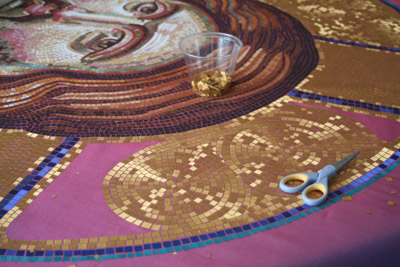
Christ Pantocrator banner (2011) – detail of work on Christ’s nimbus (halo) by Michelle L Hofer
People say that this piece is very Catholic-looking, a label Protestants seem to give this particular style of Christian art known as iconography. Iconography is not really Catholic, it is in fact the earliest Christian art form to have developed in the budding Christian world centuries ago and long before Catholicism was a thing. It was this style of art however that was deemed idolatrous at the time of the Reformation and thus has been slow to regain appreciation among Protestants.
I have been drawn to this style ever since seeing the large mosaics and frescoes in the churches of Istanbul which are some of the oldest and most extravagant worship spaces in the world. I consider this type of art to be my artistic spiritual heritage and I want to learn it and share it especially with my Protestant brothers and sisters.
Christ Pantocrator is the name given to this exact composition or pose for portraying Jesus. Pantocrator is the Greek word used in the book of Revelation for Christ and it means “Almighty Ruler”. The size of the piece gives a sense of the power and supremacy of Christ. With his right hand, Christ is gesturing a blessing to the viewer and holds a gospel book in his left (we just see the top of the book here). Behind his head is a halo called the cruciform nimbus which contains a cross-shape to indicate this is Christ. Anyone else portrayed in the icon style will have a plain empty halo.
I experienced deep peace and joy as I worked on this project and I had a very real sense of God’s presence. I still get that feeling when I view this piece hanging in my studio space. The Pantocrator banner has been loaned out to many churches and institutions since it’s creation. People tell me they enjoy sitting and just being in God’s presence with this piece. (Please drop me a line if you’d like you to make arrangements to have it displayed in your area.)
Remember the cellist I spoke of who risked his life to sit and play for the hurting people of Sarajevo. Many of those hiding out, enduring a war going on in their city, in their neighborhoods were at that time by definition “poor”. They lacked food, clean water, proper medical care, adequate shelter and clothing.
And yet those who could hear the cellist playing claimed they had been given a marvelous gift of beauty, hope and love. They needed it…as much or more so than than the things that could bring physical comfort. Art, music, literature, poetry, dance, theater, comedy, fragrance…these are not waste, they are necessity.

The Gift Bearers, 2018 by Michelle L Hofer
Maybe I should say that all again…art, music, literature, poetry, dance, theater, comedy, fragrance — these are not a waste, they are necessity for LIFE. They are food and nourishment for the senses, the soul and the spirit. They remind us and extend to us grace, joy, peace, comfort, encouragement, hope and love. We are a people designed with the capacity to need things (from both God and others) and likewise a capacity to meet one another’s needs — physical needs, but also emotional and spiritual needs.
The woman who beautifully poured out expensive, intoxicating, perfume was giving Jesus that kind of gift. That strong perfumey smell was likely to have stayed with him all the way to the hour of his death — a thing of beauty to be present with him as he went to his death.
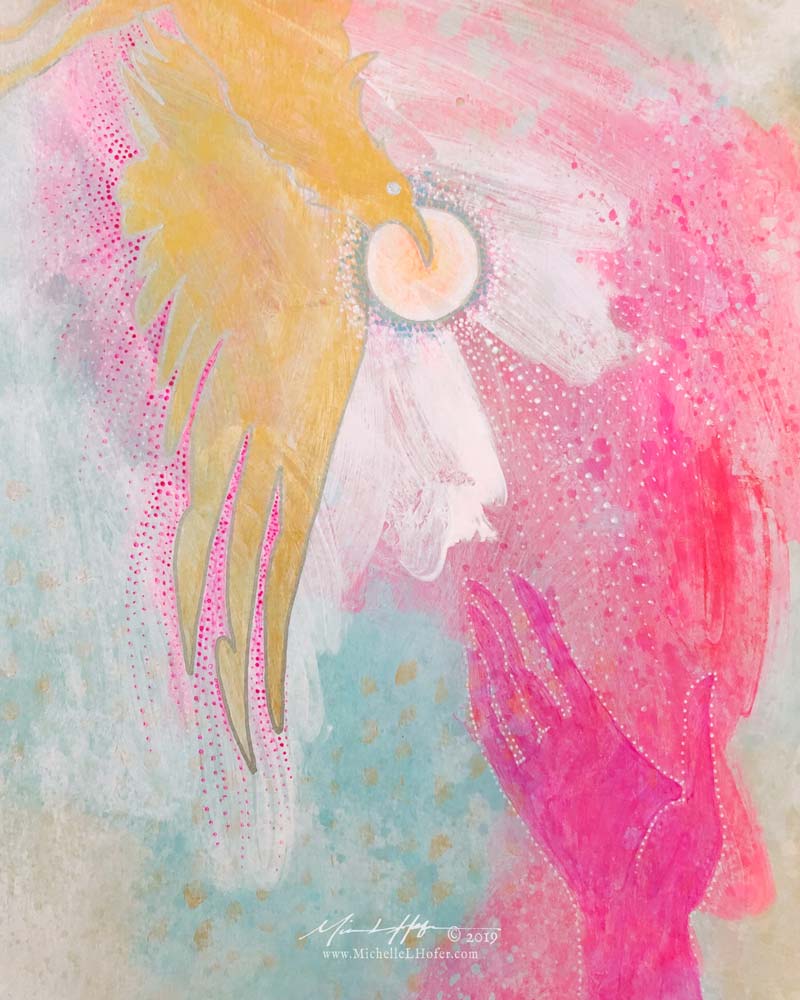
At Days End (Elijah’s Raven), 2019 by Michelle L Hofer
That perfume oil would tinge the air as Jesus was beaten.
He would smell it as he perspired and struggled to lift the cross and continue up the hill.
He would breath it in under the hot sun as his head hung in anguish.
Perhaps with each inhale it give Christ focus and strength in his final hours…and perhaps he remembered the beauty of that moment when that expensive perfume was poured over him.
Down an Ancient Path
The BIRCH TREE STUDIO BLOG
